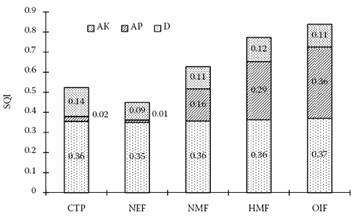Research of Farmland Management Effects on the Quality of Surface Soil during Oasefication in the Southern Rim of the Tarim Basin in Xinjiang, China made progress
2011-06-14
Oasefication and desertification are basic geographical processes in arid areas, and both change the soil properties and quality. Recently, oasefication has been obvious in the southern rim of the Tarim Basin of Xinjiang, China, and agriculture is the main land-use type. There has been little research on oasefication involving farmland of different management types in extremely arid regions.
Dr. Gui Dongwei, Xinjiang Institute of Ecology and Geography, Chinese Academy of Sciences, researched four experimental fields in the Cele oasis in 2004, representing four typical land-use types of local farmers’ tillage practices during oasefication. Three experimental fields were situated in the desert-oasis ecotone: newly cultivated land (NEF), a field with normal manure input (NMF), and a field with high manure input (HMF); there was also another field in the oasis interior (OIF), to allow analysis of the management effects on soil properties and soil quality of farmlands. Additionally, the soil from an uncultivated control plot was analyzed for comparison. Both a Soil Quality Index based on soil properties and a Sustainable Yield Index based on yearly yield were used to assess the soil quality of the different farmlands.
The result indicated that there were significant differences in seven soil indicators, including soil particle size distribution and soil organic matter, between the four locations. NEF had the lowest and OIF the highest values in all assessments among the five experiment plots. Fertilization of NMF and HMF had positive effects on soil properties and soil quality; however, the sustainable productivity of these farmlands was low. The results should be beneficial for refining agricultural management practices and improving sustainable land use in the oasefication process.
The result was published in Plant Soil Environ., 2010, 56(7): 348–356.

Fig.1 Soil quality indexes of the farmlands under different management and the individual contribution of each of the key indicators



